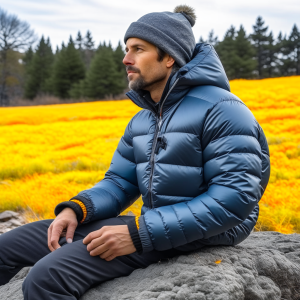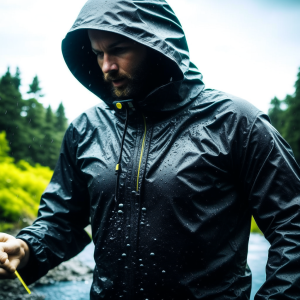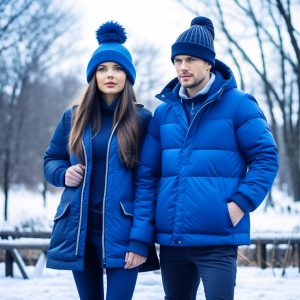Master Layered Cold Weather Clothing for Unmatched Warmth and Fashion
As winter approaches with its chilling presence, finding the perfect balance between warmth and stylish clothing becomes essential. The drop in temperatures compels many to adopt layering techniques, but have you ever considered the science behind effective layering? In this comprehensive guide, we will explore the principles of cold-weather clothing layering, revealing what makes some garments more effective than others in combating the cold, ensuring you remain both comfortable and fashionable throughout the season.
Layering clothing is not simply a fashion choice; it represents a strategic approach to heat retention and comfort during harsh weather. As temperatures drop, our bodies instinctively attempt to conserve heat by constricting blood vessels, which can often lead to cold extremities. However, this natural mechanism alone may not be sufficient. This is where the thoughtful application of layering techniques becomes vital, allowing us to create a robust barrier against the cold while maintaining comfort and mobility.

Crafting the Base Layer: Essential for Ultimate Winter Warmth
The base layer is the critical foundation of your winter wardrobe, designed to fit snugly against your skin while providing essential insulation. To appreciate the significance of this layer, we must delve into the science of moisture management and how it profoundly affects your warmth and comfort throughout the cold months ahead.
Utilizing Moisture-Wicking Fabrics for Superior Comfort
Choosing the right material for your base layer is vital for effective moisture management. The importance of moisture-wicking properties cannot be overstated. These specially crafted fabrics draw moisture away from your skin—whether from sweat or external moisture—preventing discomfort caused by wetness. A quality base layer not only acts as a moisture barrier but also keeps you dry and warm under challenging weather conditions, thereby significantly improving your overall comfort and warmth.
Understanding Insulation: Benefits of Merino Wool and Synthetic Fabrics
Let’s examine how materials such as merino wool and synthetic fibers enhance the insulating properties of your base layer. Merino wool is well-known for its natural warmth and breathability, making it an excellent choice—it not only provides insulation but also efficiently wicks moisture away. On the other hand, synthetic options like polyester and nylon offer an ideal combination of durability and insulation, creating a warm microclimate next to your skin that effectively retains body heat, ensuring you feel cozy in even the harshest conditions.
Finding the Ideal Fit: Essential Tips for Base Layer Efficiency
Selecting the correct fit for your base layer goes beyond choosing your standard size; it’s about optimizing its performance. A snug-fitting base layer maintains consistent contact with your skin, enhancing its insulating and moisture-wicking capabilities. However, achieving the right fit is crucial—too tight can restrict movement and comfort, while too loose may undermine effectiveness. When assessing fit, consider the type of activity and your overall layering plan to ensure smooth integration with your other winter garments.
Essentially, the base layer is not just another piece of clothing; it functions as a sophisticated moisture-wicking and insulating shield against the winter chill. By understanding the unique attributes of materials like merino wool and synthetic fibers, alongside mastering how to achieve the right fit, you can transform your base layer from a mere garment into a crucial element in your defense against the cold.
Maximizing Insulation: Your Key to Retaining Body Heat
 Moving on to the insulating layer, we emphasize its vital role in capturing and retaining heat around your body. This layer is essential in the science of heat retention, acting as a protective cocoon against the elements. We'll discuss important factors such as warmth-to-weight ratios, the advantages of down insulation, and the environmentally friendly benefits of synthetic options.
Moving on to the insulating layer, we emphasize its vital role in capturing and retaining heat around your body. This layer is essential in the science of heat retention, acting as a protective cocoon against the elements. We'll discuss important factors such as warmth-to-weight ratios, the advantages of down insulation, and the environmentally friendly benefits of synthetic options.
Decoding Warmth-to-Weight Ratios for Effective Insulation
Understanding warmth-to-weight ratios is crucial when selecting your insulating layer. This principle dictates that insulation materials should offer exceptional warmth without adding unnecessary bulk. Essentially, it’s about maximizing warmth while minimizing weight, allowing for ease of movement and comfort. This equilibrium is particularly important for those who desire insulation without feeling encumbered, enabling unrestricted activity even in chilly conditions.
Down Insulation: Featherlight Warmth for Outdoor Enthusiasts
Down insulation is a top choice for those seeking unrivaled warmth in a lightweight format. Sourced from the soft feathers of ducks and geese, down is famous for its remarkable warmth-to-weight ratio. Its lightweight and compressible nature makes it a favorite among winter adventurers who need effective insulation without sacrificing mobility. Recognizing the advantages of down insulation is key in understanding its role in creating an insulating layer that seamlessly combines warmth, comfort, and flexibility.
Choosing Synthetic Insulation: Ethical Warmth for All Conditions
Synthetic insulation materials, primarily composed of polyester fibers, have gained popularity as ethical alternatives in the insulation landscape. What sets synthetic insulation apart is its ability to retain warmth even in wet conditions, a performance area where down may falter. This durability in unpredictable weather makes synthetic materials ideal for various climates. Moreover, selecting synthetic options aligns with ethical considerations, allowing you to enjoy warmth without compromising your values.
Finding the Right Thickness: Precision in Insulation Choices
Selecting the appropriate thickness for your insulating layer demands careful consideration; precision is paramount. Evaluate the expected degree of cold exposure alongside your layering strategy when determining thickness. In milder climates, a thinner insulating layer may suffice, while harsher conditions might require a thicker, more robust option. By grasping the complexities of insulation thickness, you can customize your insulating layer to meet the specific needs of your winter activities.
In the end, the insulating layer transcends traditional clothing roles, becoming a strategic partner in the battle against the cold. By understanding warmth-to-weight ratios, appreciating the benefits of down insulation as well as synthetic alternatives, and providing insights on thickness selection, we redefine the insulating layer as a calculated defense mechanism against winter’s icy embrace.
Establishing Your Outermost Layer: The Ultimate Defense Against Winter's Harsh Conditions
The outermost layer acts as your essential barrier against biting winds and frigid temperatures. This layer serves two vital functions: it protects against environmental elements while also significantly contributing to moisture regulation. As we delve deeper into the outer layer, we will uncover the importance of breathability, the transformative advantages of DWR finishes and Gore-Tex membranes, and key windproof features that enhance insulation performance.
Breathability: The Foundation of Comfort and Moisture Control
Often underestimated, breathability is a crucial feature of the outer layer that greatly influences overall comfort. This aspect refers to the fabric’s ability to allow perspiration vapor to escape from your body while preventing external moisture from penetrating. Achieving this delicate balance keeps you dry and comfortable, thus alleviating the chilling effects of trapped moisture. A breathable outer layer is indispensable for maintaining a cozy microclimate within your clothing, ensuring maximum comfort during adverse weather conditions.
DWR Finishes and Gore-Tex: The Pinnacle of Waterproofing Innovation
 DWR (Durable Water Repellent) coatings and Gore-Tex membranes set the standard in cold-weather outerwear. DWR finishes provide fabrics with water-repellent characteristics, creating an effective barrier against rain, sleet, and snow. Gore-Tex and similar technologies take waterproofing to new levels by offering an ideal combination of impermeability and breathability. Understanding how these technologies work together is essential for staying dry and comfortable, even in the most severe weather conditions.
DWR (Durable Water Repellent) coatings and Gore-Tex membranes set the standard in cold-weather outerwear. DWR finishes provide fabrics with water-repellent characteristics, creating an effective barrier against rain, sleet, and snow. Gore-Tex and similar technologies take waterproofing to new levels by offering an ideal combination of impermeability and breathability. Understanding how these technologies work together is essential for staying dry and comfortable, even in the most severe weather conditions.
Windproof Features: Enhancing Protection Against Cold Winds
Windproof characteristics are vital in frigid weather, especially when biting gales can penetrate even the strongest fabrics. The windproof outer layer acts as a formidable shield against cold air, promoting comfort while protecting the insulation of inner layers. By blocking chilly winds, your outer layer becomes an essential defender, ensuring that your thoughtfully selected layers function together to keep you warm and shielded from harsh elements.
Ultimately, the outermost layer is more than a mere protective shell; it is a sophisticated barrier that expertly balances breathability with waterproofing. By recognizing the importance of breathability, exploring the innovations of DWR finishes and Gore-Tex membranes, and understanding the role of windproof features, we elevate the outer layer to an advanced garment that excels in style, functionality, and weather resistance.
Actionable Strategies for Achieving Ultimate Warmth and Style This Winter
With a strong grasp of effective layering strategies established, let’s dive into practical tips and tactics to enhance your cold-weather experience, seamlessly combining warmth with enduring style. Accessories play a crucial role in winter attire, often acting as unsung heroes that can elevate your wardrobe. From the essential warmth provided by well-selected gloves to the stylish flair of a cozy hat and the comfort of thermal socks, these seemingly minor details are crucial in creating a fashionable and comfortable winter ensemble.
The Crucial Role of Accessories: Beyond Aesthetic Appeal
Accessories are far more than simple decorations; they are vital components of your defense against the cold. Beyond their aesthetic appeal, items such as gloves, hats, and thermal socks perform key functions in enhancing your overall warmth. By thoughtfully incorporating these accessories, you can ensure that every part of your body is shielded from the chill, effectively preventing valuable body heat from escaping into the frigid air.
Investing in Quality Accessories: Recommendations for Unmatched Comfort
The quest for warmth extends beyond your base and insulating layers; it also includes the careful selection of accessories. Invest in high-quality gloves made from insulating materials such as fleece or lined leather to establish a sturdy barrier against the cold. A warm hat featuring additional insulation or a cozy faux-fur lining not only adds a touch of elegance but also helps in retaining heat. Choose thermal socks crafted from merino wool or advanced synthetic blends to guarantee maximum warmth and efficient moisture management.
Fashion-Forward Tips: Blending Functionality with Style
Staying warm during freezing temperatures doesn’t necessitate sacrificing style. Utilize these creative styling techniques to navigate the winter landscape with elegance. Experiment with layering various textures in your outfit to create visual intrigue while simultaneously boosting insulation. Select winter-appropriate colors that complement the snowy backdrop, and don’t hesitate to accessorize with bold pieces like a vibrant scarf or chic earmuffs to elevate your overall appearance.
In essence, accessories are the understated architects of a well-rounded winter outfit. They not only enhance warmth but also allow you to express your style even in the coldest conditions. By selecting high-quality accessories and infusing your winter wardrobe with thoughtful styling, you can conquer the chill while showcasing undeniable elegance.
Embrace the Integration of Style and Functionality in Your Winter Wardrobe
As we conclude our exploration of overcoming the cold, it’s vital to acknowledge the significance of style in winter apparel. Dressing for the cold does not require sacrificing your fashion sense; rather, today’s fashion environment celebrates the fusion of functionality and flair. Numerous outdoor and fashion brands have recognized and embraced the demand for winter gear that not only keeps you warm but also radiates confidence and contemporary sophistication.
The Evolution of Cold-Weather Clothing: A Stylish New Era
 The cold-weather clothing industry is undergoing a transformative phase, where winter gear evolves from mere utility to become a symbol of innovation and style. Designers and brands are increasingly recognizing the need for clothing that seamlessly blends practicality with aesthetic appeal. This shift has ushered in a new era of outerwear that not only offers warmth but also captivates with its visual charm.
The cold-weather clothing industry is undergoing a transformative phase, where winter gear evolves from mere utility to become a symbol of innovation and style. Designers and brands are increasingly recognizing the need for clothing that seamlessly blends practicality with aesthetic appeal. This shift has ushered in a new era of outerwear that not only offers warmth but also captivates with its visual charm.
Leading Brands: Uniting Style with Function
Several brands are at the forefront of this style revolution, skillfully merging fashion with functionality in their winter apparel. Canada Goose is renowned for its luxurious down coats that deliver remarkable warmth without compromising style. The North Face integrates cutting-edge technology into its designs, creating outerwear that harmonizes chic aesthetics with practical functionality. Meanwhile, Moncler has redefined the puffer jacket, transforming it into a high-fashion statement piece, illustrating that winter clothing can be both practical and runway-ready.
Effective Styling: Elevate Your Winter Fashion Experience
Let’s explore innovative ways to merge warmth and style in your winter outfits. Choose standout pieces that fulfill both functional and aesthetic roles, such as a beautifully tailored wool coat or a sleek parka that serves as the focal point of your ensemble. Experiment with layering a chunky knit sweater over a fitted jacket for a cozy yet stylish appearance. Don’t hesitate to introduce vibrant colors into your winter look by accessorizing with eye-catching scarves or trendy boots.
Ultimately, embracing style in the cold is no longer a contradiction; it’s a vibrant reality shaped by a dynamic fashion industry. As stylish cold-weather gear emerges, backed by innovative brands, the narrative shifts from mere survival to personal expression. So, immerse yourself in this style renaissance, choose pieces that empower you, and redefine the boundaries of fashion amid the winter's embrace.
The post Cold Weather Clothing Layers: The Science Explained appeared first on Survival Bite.
The Article Cold Weather Clothing Layers Explained: Understanding the Science Was Found On https://limitsofstrategy.com


Your exploration of the science behind cold weather layering truly resonates with me, especially as the winter season approaches and the struggle to stay warm yet stylish intensifies. I’ve often found myself in the predicament of trying to piece together an outfit that not only withstands the freezing temperatures but also reflects my personal style. Your argument that layering is not merely a fashion choice but rather a strategic means of heat retention highlights an important point that many might overlook.
It’s great to hear that you found the exploration of cold weather layering relatable. The struggle to balance warmth with personal style is one that many of us face as the winter season rolls around. It can feel overwhelming trying to navigate both function and fashion, especially when you look at the options available. It’s interesting how layering, often viewed as a practical solution, can also become an artistic expression if you approach it with an open mind.
I really appreciate how you framed layering as this blend of practicality and artistry. It’s true that winter can sometimes feel like a battle between staying warm and looking good. I used to focus mainly on warmth, but I’ve started to see how experimenting with different textures, colors, and even accessories can really elevate an outfit.
It’s great to hear you’re diving into the fun side of layering! It really is a game-changer when you start mixing textures and colors. I’ve found that combining a chunky knit with a sleek leather jacket can add so much depth to an outfit. And don’t underestimate accessories—scarves, hats, and even jewelry can turn a basic look into something special. Plus, you get to play around with different styles, which can make those chilly winter months a bit more exciting. What’s been your favorite combo so far?
I’m glad you found that perspective helpful! If you’re interested in exploring more tips on mastering the art of layering, check out this guide that dives into stylish ways to blend warmth and creativity in your winter wardrobe.
https://mannland5.com/quillbot
I really relate to your thoughts on the balance between warmth and personal style during the winter. It’s funny how our approach to cold weather fashion can really reflect our individuality. Layering can definitely start as a practical necessity, but when you take the time to play with colors, textures, and lengths, it turns into something much more creative.
You nailed it with the idea that layering goes beyond just staying warm. It really does open up a world of creativity. Choosing different fabrics—like pairing a chunky knit with a sleek leather jacket—adds both dimension and personality to an outfit. Plus, playing with different lengths can create such an interesting silhouette. It’s all about creating that balance while expressing who we are.
I’m glad you connected with that! If you’re looking for some inspiration to elevate your winter wardrobe, check out this collection that perfectly blends warmth and style.
https://mannland5.com/octopus
Your insights into layered cold weather clothing struck a chord with me, especially the emphasis on not just fashion but the science behind it. I’ve often found that mastering the art of layering transforms my winter experience from one of discomfort to a cozy celebration of the season.
I’m glad the piece resonated with you. It’s surprising how much of a difference getting the layering right can make. It’s like a little secret hack for winter. I remember the first time I really focused on it—I went from shivering through the season to feeling surprisingly snug and even enjoying some outdoor adventures.
It’s great to hear how the concept of layering has modified your winter experience. It’s fascinating to think about how something as simple as the way we dress can transform an entire season from something harsh and unpleasant into a period of enjoyment.
I’m glad to hear that layering has enhanced your winter experience! If you’re looking to elevate your cozy attire even further, check out this resource for some great tips and product recommendations.
https://mannland5.com/octopus
It’s interesting to think about how our approach to dressing can really shape our experiences, isn’t it? Layering is such a practical way to embrace the cold, yet it also allows for a bit of creativity and expression. I’ve found that it can become almost a form of self-care during the winter months. Instead of feeling overwhelmed by the cold, I find myself looking forward to mixing textures and colors.
I completely agree with your thoughts on layering. It’s fascinating how something as simple as clothing choices can influence our mindset and experiences. Finding joy in combining different textures and colors can transform cold, dreary days into opportunities for creativity.
You bring up such a great point about clothing choices and their impact on our mindset. It’s like this hidden power we often overlook. I’ve noticed that when I’m feeling a little down or stuck in a rut, putting on a piece that I love—even if it’s just a cozy sweater or a vibrant scarf—can completely shift my mood.
Layering can really change how we perceive winter, can’t it? It’s fascinating how something as simple as clothing can completely alter our interaction with the cold, almost turning it into a form of self-expression rather than a hardship. When you think about it, the art of layering transcends just keeping warm; it’s about finding joy in the season itself.
You’ve captured the essence of layering beautifully. It really does transform how we engage with winter, doesn’t it? I’ve found that layering not only helps with the practicalities of staying warm but also allows for a kind of creativity that can be overlooked in other seasons. Choosing different textures, colors, and patterns can be like assembling a personal canvas where your mood and personality shine through.
You’ve really hit on something important about layering. It’s not just a way to fend off the chill; it opens up a whole avenue for self-expression. Winter gives us a unique opportunity to showcase our style through those creative combinations of textures and colors.
You’ve made an excellent point about layering and how it shapes our experience of winter. It’s interesting to consider how clothing, often viewed merely as a functional barrier against the cold, can evolve into a canvas for personal expression. When we layer up, we’re not just bundling ourselves against the chill; we’re also curating a reflection of our mood, style, and perhaps even a bit of our personality.
Absolutely! Embracing the art of layering not only elevates our winter style but also enhances our enjoyment of the season. Discover some inspiring layering pieces that can help you express your individuality while staying cozy by checking out our collection here!
https://mannland5.com/webilaro
You’ve touched on a really fascinating aspect of winter dressing. Layering indeed transforms clothing into much more than just a shield from the cold; it becomes a way to express who we are in a season that can sometimes feel a bit monotonous. I find it intriguing how certain items can evoke memories or moods, like that oversized sweater that reminds you of cozy nights by the fireplace or that vibrant scarf that brings a burst of color to the gray days.
It’s interesting how mastering the art of three-tiered layers can really transform not just our warmth but also how we express ourselves in the chilly months ahead.
‘Three-Tiered Layers: The Ultimate Expert Guide’
https://mannland5.com/three-tiered-layers-the-ultimate-expert-guide/.
I totally get what you’re saying about layering turning winter into a more enjoyable experience. It really is like an art form, and once you get the hang of it, your whole vibe changes. The science behind it, especially, makes it fascinating—each layer has a purpose beyond just looking good.
I’m glad to hear that! If you’re looking to further enhance your winter wardrobe, check out this collection that beautifully blends style and functionality.
https://mannland5.com/octopus
You make a great point about layering being an art form. It’s interesting how the right combination can really shift not just your look but also your mood. When you understand how different materials work together—like insulating wool or moisture-wicking fabrics—it’s amazing how you can feel comfortable even in the coldest weather.
Your insights into the science of layering for cold weather are incredibly relevant, especially as winter approaches. I’ve often grappled with the challenge of staying warm while maintaining a sense of style, and your explanation about the body’s mechanisms for heat retention really sheds light on why layering is so crucial.
I completely understand the struggle of trying to stay warm while also looking stylish. It can be a real balancing act, can’t it? I’ve found that the art of layering not only helps with warmth but also adds an interesting dimension to outfits. It’s almost like painting with fabrics—choosing textures and colors that complement each other while keeping your body’s heat regulation in mind.
You’ve really captured the essence of layering. It’s fascinating how a well-thought-out outfit can not only keep us warm but also tell a story through the textures and colors we choose. When you think about it, layering really does feel like a creative process, doesn’t it? Just like a painter selects each color carefully, we can curate our wardrobe to manage not just our comfort but also our mood and personality.
Absolutely, layering truly is like an art form! If you’re looking for some inspiring pieces to elevate your winter wardrobe while staying cozy, check out this collection that beautifully blends style and warmth.
https://mannland5.com/quillbot
You’ve hit the nail on the head with that comparison to painting. Each layer really does allow us to express not just our style but also our mood on any given day. I often think about how the colors and textures we choose can influence our feelings—like how a cozy wool sweater in earthy tones can evoke a sense of comfort and nostalgia, while a vibrant scarf can lift our spirits.
You nailed it with the idea of treating outfits like a canvas. Layering really is an art form that requires a bit of finesse. I mean, one minute you’re trying to look like a chic, runway model, and the next you’ve morphed into a human burrito. It’s a delicate balance, like playing Jenga with your wardrobe.
You brought up a good point about the balance in layering. It’s like trying to find that sweet spot between cozy and looking like you’ve just rolled out of a taco truck. I think the trick is to pay attention to proportions and textures. For example, a fitted base layer can really help keep a look polished, even when you pile on those oversized pieces.
“Absolutely! Finding that sweet spot is key. If you’re looking to elevate your layering game even further, check out this guide I put together—it’s packed with tips to help you avoid becoming a human burrito!”
https://mannland5.com/octopus
Ah, the art of layering—a skill most akin to an Olympic sport, if you ask me. I once left the house in a flurry of wooly enthusiasm, only to realize that my outer layers turned me into a walking marshmallow. Who knew looking like a snack could be so uncomfortable? The balance between warmth and style truly is a fine line to walk!
Your insight into the science of layering is spot on and suggests a deeper understanding of how clothing interacts with our bodies. I’ve found that not all materials are created equal when it comes to layering; for instance, merino wool has been a game-changer for me during winter treks. Its moisture-wicking properties and thermal regulation keep me warm without overheating, which is crucial when moving between indoor and outdoor environments.
You’ve hit on a really important point about materials and their performance in different conditions. Merino wool is truly something special. It’s fascinating how it manages to keep you warm while allowing for breathability. I’ve had similar experiences where switching to better fabrics transformed my comfort on the trails.